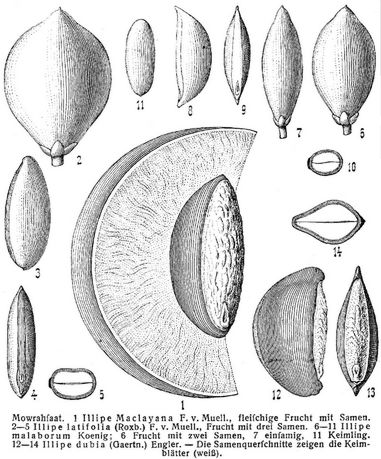- Mahwa
Mahwa (Mowrah). Mit dem Namen Mahwa werden in Britisch-Ostindien mehrere Arten der Gattung Illipe (Sapotaceen) bezeichnet, deren Samen ein viel verwendetes Fett liefern. Die Ausfuhr der meist geschälten Kerne hat sich bei dem großen europäischen Bedarf an Pflanzenfetten bedeutend gesteigert. Wenn man von der nur auf den subtropischen Abhängen des Himalaja, Kumaon, Bhotan, vorkommenden Illipe butyracea (Roxb.) Engl. absieht, deren kleine, kaum 2 cm lange Kerne bis jetzt keinen Handelsartikel bilden und nur lokal zur Herstellung der geschätzten Phulwabutter dienen, sowie von der auf die südliche Westküste beschränkten Illipe malabarica (Bedd.) Engl., die beide ebenfalls als Mahwa bezeichnet werden, so ist es in der Hauptsache Illipe latifolia (Bedd.) Engl. und daneben Illipe longifolia L. (I. malaborum Koen.), welche die Mowrahsaat des Handels liefern. Wenn auch die Handelsware nur aus den Kernen (getrennten Keimblättern) besteht, deren Struktur bei beiden Arten keine besonderen anatomischen Unterschiede aufweist, so finden sich doch meistens noch größere Mengen unversehrten Samens oder größerer Schalenteile, die noch eine Bestimmung der Art gestatten, wobei besonders die Gestalt der Ansatzstelle von Wichtigkeit ist.
Illipe latifolia: Samen zu 1–4, eiförmig, oft durch gegenseitigen Druck etwas abgeplattet, 2–3 cm lang, in der Mitte bis 16 mm breit und 14 mm dick, mit schwach[420] gekielter Außenseite, am Scheitel abgerundet, an der Basis schwach zugespitzt. Samenschale etwas lederartig, lebhaft glänzend, braun, bisweilen heller, trübgelblich. Ansatzstelle der Bauchseite breit gegen die Mitte deutlich verschmälert, fast über die ganze Länge des Samens reichend. Illipe longifolia: Samen einzeln, seltener zu zweien und dann sich gegenseitig in der Längsrichtung seitlich leicht abplattend, schlank, ellipsoidisch, 4–4,5 cm lang (selten mehr), in der Mitte bis 14 mm breit und 10 mm dick, mit gerader Innenkante und etwas gebogener Außenseite, an beiden Enden gewöhnlich mit einem kurzen einwärts gekrümmten Schnabel. Samenschale dünn, ockerbraun, etwas glänzend, Ansatzstelle nahezu gleichmäßig schmal an der Innenkante, über die ganze Länge des Samens reichend, Illipe und Mowrah dienen zur Herstellung von Schokoladefetten. – S.a. Mowrahöl.
Die Preßrückstände der Mowrah enthalten sehr giftige Saponine, deren Gewinnung die Oelfabrik Großgerau-Bremen in die Hand genommen hat.
Literatur: Jahrb. d. Hamburgisch. Wissenschaftl. Anstalten XXXI, 1913, S. 22–25, und XXXII, 1914, S. 18 (Jahresber. d. Institus f. angewandte Botanik). – A. Engler, Sapotaceae in Englers Monographien afrik. Pflanzenfamilien VIII, 1904, S. 18.
Ernst Gilg und Julius Schuster.
http://www.zeno.org/Lueger-1904.

